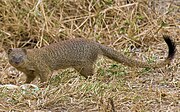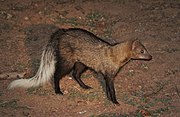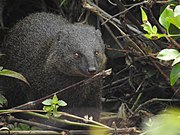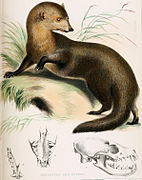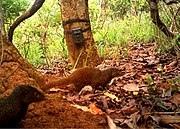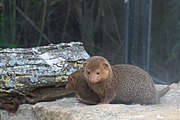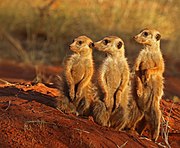Herpestidae is a family of mammals in the order Carnivora, composed of the mongooses and the meerkat. A member of this family is called a mongoose or a herpestid. They are widespread primarily throughout Africa and south Asia, and are found primarily in forests, savannas, shrublands, and grasslands, though some species can be found in wetlands or deserts. Most mongooses are 30–60 cm (12–24 in) long, plus a 20–40 cm (8–16 in) tail, though the Ethiopian dwarf mongoose can be as small as 18 cm (7 in) plus a 12 cm (5 in) tail, and the white-tailed mongoose can be up to 104 cm (41 in) plus a 47 cm (14 in) tail. Most species do not have population estimates, though one, the Liberian mongoose, is classified as vulnerable with a population size of around 5,000. No herpestid species have been domesticated.

The 34 species of Herpestidae are split into 14 genera within 2 subfamilies: Herpestinae, comprising 23 extant species that are native to southern Europe, Africa and Asia, and Mungotinae, comprising 11 extant species native to Africa. Extinct species have also been placed into both subfamilies, though some older extinct species have not been categorized into a subfamily. Around ten extinct Herpestidae species have been discovered, though due to ongoing research and discoveries the exact number and categorization is not fixed. Herpestidae is believed to have diverged from the existing Feliformia suborder around 21.8 million years ago in the Early Miocene.[1]
Conventions
| Conservation status | |
|---|---|
| EX | Extinct (0 species) |
| EW | Extinct in the wild (0 species) |
| CR | Critically Endangered (0 species) |
| EN | Endangered (0 species) |
| VU | Vulnerable (1 species) |
| NT | Near threatened (3 species) |
| LC | Least concern (29 species) |
| Other categories | |
| DD | Data deficient (1 species) |
| NE | Not evaluated (0 species) |
Conservation status codes listed follow the International Union for Conservation of Nature (IUCN) Red List of Threatened Species. Range maps are provided wherever possible; if a range map is not available, a description of the herpestid's range is provided. Ranges are based on the IUCN Red List for that species unless otherwise noted.
Classification
The family Herpestidae consists of 34 extant species belonging to 15 genera in 2 subfamilies and divided into dozens of extant subspecies. This does not include hybrid species or extinct prehistoric species.
- Subfamily Herpestinae
- Genus Atilax: one species
- Genus Bdeogale: three species
- Genus Cynictis: one species
- Genus Herpestes: five species
- Genus Ichneumia: one species
- Genus Paracynictis: one species
- Genus Rhynchogale: one species
- Genus Urva: nine species
- Genus Xenogale: one species
- Subfamily Mungotinae
- Genus Crossarchus: four species
- Genus Dologale: one species
- Genus Helogale: two species
- Genus Liberiictis: one species
- Genus Mungos: two species
- Genus Suricata: one species
|
Herpestids
The following classification is based on the taxonomy described by Mammal Species of the World (2005), with augmentation by proposals accepted by the American Society of Mammalogists since using molecular phylogenetic analysis.[2][3]
Subfamily Herpestinae
| Common name | Scientific name and subspecies | Range | Size and ecology | IUCN status and estimated population |
|---|---|---|---|---|
| Marsh mongoose | A. paludinosus (G. Cuvier, 1829) Eleven subspecies
| Sub-Saharan Africa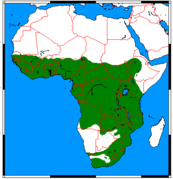 | Size: 46–64 cm (18–25 in) long, plus 31–41 cm (12–16 in) tail[4] Habitat: Forest, grassland, inland wetlands, neritic marine, and coastal marine[5] Diet: Crustaceans as well as other aquatic prey and rodents[5] | LC
|
| Common name | Scientific name and subspecies | Range | Size and ecology | IUCN status and estimated population |
|---|---|---|---|---|
| Black-footed mongoose | B. nigripes Pucheran, 1855 | Central Africa | Size: 45–65 cm (18–26 in) long, plus 30–40 cm (12–16 in) tail[4] Habitat: Forest[6] Diet: Mammals, as well as reptiles, birds, insects, and centipedes[6] | LC
|
| Bushy-tailed mongoose | B. crassicauda Peters, 1852 Five subspecies
| Southeast Africa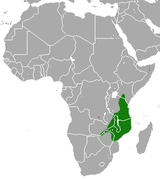 | Size: 36–52 cm (14–20 in) long, plus 22–29 cm (9–11 in) tail[4] Habitat: Forest, savanna, and shrubland[7] Diet: Omnivorous[7] | LC
|
| Jackson's mongoose | B. jacksoni (Thomas, 1894) | East-central Africa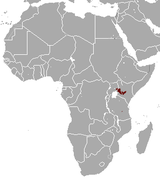 | Size: 50–58 cm (20–23 in) long, plus 28–33 cm (11–13 in) tail[4] Habitat: Forest[8] Diet: Rodents and insects[4][8] | NT
|
| Common name | Scientific name and subspecies | Range | Size and ecology | IUCN status and estimated population |
|---|---|---|---|---|
| Yellow mongoose | C. penicillata (Cuvier, 1829) Twelve subspecies
| Southern Africa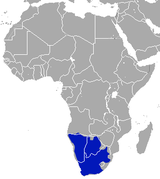 | Size: 26–46 cm (10–18 in) long, plus 16–30 cm (6–12 in) tail[4] Habitat: Savanna, shrubland, and grassland[9] Diet: Insects, as well as rodents, birds, other vertebrates, and arachnids[9] | LC
|
| Common name | Scientific name and subspecies | Range | Size and ecology | IUCN status and estimated population |
|---|---|---|---|---|
| Angolan slender mongoose | H. flavescens Bocage, 1889 Two subspecies
| Southwestern Africa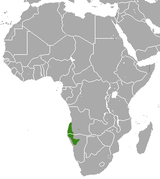 | Size: 31–36 cm (12–14 in) long, plus 31–37 cm (12–15 in) tail[10] Habitat: Shrubland and rocky areas[11] Diet: Invertebrates, small mammals, birds, lizards, and snakes[11] | LC
|
| Egyptian mongoose | H. ichneumon (Linnaeus, 1758) Eleven subspecies
| Sub-Saharan Africa, Nile river, and Mediterranean (native, green); Iberian peninsula (introduced, red)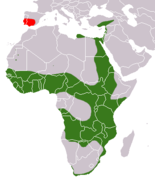 | Size: 48–60 cm (19–24 in) long, plus 33–55 cm (13–22 in) tail[12] Habitat: Forest, savanna, shrubland, grassland, and inland wetlands[13] Diet: Omnivorous[13] | LC
|
| Cape gray mongoose | H. pulverulentus Wagner, 1839 Three subspecies
| Southern Africa | Size: 29–43 cm (11–17 in) long, plus 20–34 cm (8–13 in) tail[14] Habitat: Shrubland and inland wetlands[15] Diet: Small mammals and insects[15] | LC
|
| Common slender mongoose | H. sanguineus Rüppell, 1836 26 subspecies
| Sub-Saharan Africa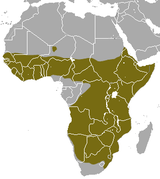 | Size: 27–35 cm (11–14 in) long, plus 19–33 cm (7–13 in) tail[10] Habitat: Forest, savanna, shrubland, and grassland[16] Diet: Small vertebrates and invertebrates[16] | LC
|
| Somalian slender mongoose | H. ochraceus Gray, 1848 Four subspecies
| Eastern Africa | Size: 25–29 cm (10–11 in) long, plus 22–28 cm (9–11 in) tail[10] Habitat: Shrubland and desert[17] Diet: Believed to be invertebrates and small vertebrates[10][17] | LC
|
| Common name | Scientific name and subspecies | Range | Size and ecology | IUCN status and estimated population |
|---|---|---|---|---|
| White-tailed mongoose | I. albicauda (Cuvier, 1829) Seven subspecies
| Sub-Saharan Africa, southern Arabic peninsula | Size: 51–104 cm (20–41 in) long, plus 34–47 cm (13–19 in) tail[4] Habitat: Forest, savanna, shrubland, grassland, and inland wetlands[18] Diet: Insects[18] | LC
|
| Common name | Scientific name and subspecies | Range | Size and ecology | IUCN status and estimated population |
|---|---|---|---|---|
| Selous's mongoose | P. selousi (Winton, 1896) Four subspecies
| Southern Africa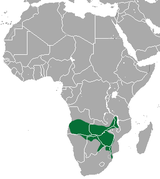 | Size: 63–90 cm (25–35 in) long, plus 28–43 cm (11–17 in) tail[19] Habitat: Savanna and grassland[20] Diet: Invertebrates, as well as small rodents, amphibians, reptiles, and birds[19][20] | LC
|
| Common name | Scientific name and subspecies | Range | Size and ecology | IUCN status and estimated population |
|---|---|---|---|---|
| Meller's mongoose | R. melleri (Gray, 1865) Two subspecies
| Southeastern Africa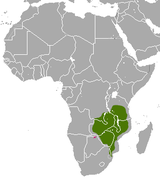 | Size: 36–57 cm (14–22 in) long, plus 30–42 cm (12–17 in) tail[4] Habitat: Forest, savanna, and shrubland[21] Diet: Termites, as well as other invertebrates[4][21] | LC
|
| Common name | Scientific name and subspecies | Range | Size and ecology | IUCN status and estimated population |
|---|---|---|---|---|
| Collared mongoose | U. semitorquata (Gray, 1846) Two subspecies
| Borneo in Southeast Asia | Size: 40–46 cm (16–18 in) long, plus 25–31 cm (10–12 in) tail[10] Habitat: Forest[22] Diet: Unknown[10][22] | NT
|
| Crab-eating mongoose | U. urva (Hodgson, 1836) Four subspecies
| Eastern and Southeast Asia | Size: 45–50 cm (18–20 in) long, plus 25–30 cm (10–12 in) tail[23] Habitat: Forest, shrubland, and grassland[24] Diet: Crustaceans, mammals, reptiles, insects, and amphibians[24] | LC
|
| Indian brown mongoose | U. fusca (Waterhouse, 1838) Five subspecies
| South India, Sri Lanka | Size: 33–48 cm (13–19 in) long, plus 20–33 cm (8–13 in) tail[23] Habitat: Forest and grassland[25] Diet: Believed to be a variety of small vertebrates and invertebrates[10][25] | LC
|
| Indian grey mongoose | U. edwardsii (Geoffroy, 1818) Five subspecies
| India, west Asia | Size: 36–45 cm (14–18 in) long, plus 32–45 cm (13–18 in) tail[23] Habitat: Forest, shrubland, and grassland[26] Diet: Small mammals, birds, reptiles, eggs, and invertebrates[10][26] | LC
|
| Javan mongoose | U. javanica (Geoffroy, 1818) Nine subspecies
| Southeast Asia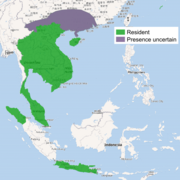 | Size: 25–37 cm (10–15 in) long, plus 24–27 cm (9–11 in) tail[27] Habitat: Forest, savanna, shrubland, grassland, and inland wetlands[28] Diet: Invertebrates, as well as rodents, birds, snakes, lizards, frogs, fish, and fruit[27][28] | LC
|
| Small Indian mongoose | U. auropunctata (Hodgson, 1836) Three subspecies
| West, south, and southeast Asia | Size: 25–37 cm (10–15 in) long, plus 24–27 cm (9–11 in) tail[27] Habitat: Forest, savanna, shrubland, grassland, and inland wetlands[28] Diet: Invertebrates, as well as rodents, birds, snakes, lizards, frogs, fish, and fruit[27][28] | LC
|
| Ruddy mongoose | U. smithii (Gray, 1837) Three subspecies
| India and Sri Lanka | Size: 39–45 cm (15–18 in) long, plus 35–47 cm (14–19 in) tail[23] Habitat: Forest and shrubland[29] Diet: Rodents, birds, and reptiles[10][29] | LC
|
| Short-tailed mongoose | U. brachyura (Gray, 1837) Six subspecies
| Southeast Asia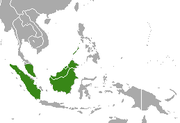 | Size: 38–45 cm (15–18 in) long, plus 20–25 cm (8–10 in) tail[30] Habitat: Forest and shrubland[31] Diet: Invertebrates and small vertebrates[31] | NT
|
| Stripe-necked mongoose | U. vitticolla (Bennett, 1835) Two subspecies
| Southern India and Sri Lanka | Size: 25–41 cm (10–16 in) long, plus 22–36 cm (9–14 in) tail[23] Habitat: Forest and shrubland[32] Diet: Small mammals, birds, birds' eggs, reptiles, fish, insects, and roots[32] | LC
|
| Common name | Scientific name and subspecies | Range | Size and ecology | IUCN status and estimated population |
|---|---|---|---|---|
| Long-nosed mongoose | X. naso (Winton, 1901) | Central Africa | Size: 40–61 cm (16–24 in) long, plus 32–43 cm (13–17 in) tail[4] Habitat: Forest and inland wetlands[33] Diet: Omnivorous[33] | LC
|
Subfamily Mungotinae
| Common name | Scientific name and subspecies | Range | Size and ecology | IUCN status and estimated population |
|---|---|---|---|---|
| Alexander's kusimanse | C. alexandri Thomas, 1907 | Central Africa | Size: 37–44 cm (15–17 in) long, plus 24–32 cm (9–13 in) tail[4] Habitat: Forest[34] Diet: Invertebrates and fruit, as well as frogs, snakes, and carrion[4][34] | LC
|
| Angolan kusimanse | C. ansorgei Thomas, 1910 Two subspecies
| Central Africa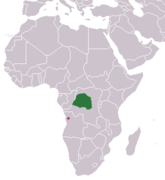 | Size: 32–35 cm (13–14 in) long, plus 20–22 cm (8–9 in) tail[4] Habitat: Forest[35] Diet: Insects, small vertebrates, and eggs[4][35] | LC
|
| Common kusimanse | C. obscurus F. Cuvier, 1825 | Western Africa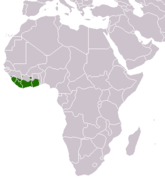 | Size: 29–37 cm (11–15 in) long, plus 14–21 cm (6–8 in) tail[4] Habitat: Forest and savanna[4][36] Diet: Insects, as well as reptiles, small mammals, and fruit[36] | LC
|
| Flat-headed kusimanse | C. platycephalus Goldman, 1984 | Western central Africa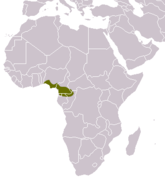 | Size: 21–47 cm (8–19 in) long, plus 15–21 cm (6–8 in) tail[37] Habitat: Forest and inland wetlands[38] Diet: Insects, as well as reptiles, small mammals, and fruit[4][38] | LC
|
| Common name | Scientific name and subspecies | Range | Size and ecology | IUCN status and estimated population |
|---|---|---|---|---|
| Pousargues's mongoose | D. dybowskii (Pousargues, 1893) | Central Africa | Size: 24–30 cm (9–12 in) long, plus 16–22 cm (6–9 in) tail[4] Habitat: Forest, savanna, and grassland[39] Diet: Invertebrates[4][39] | DD
|
| Common name | Scientific name and subspecies | Range | Size and ecology | IUCN status and estimated population |
|---|---|---|---|---|
| Common dwarf mongoose | H. parvula (Sundevall, 1847) Seven subspecies
| Southern and eastern Africa | Size: 18–23 cm (7–9 in) long, plus 14–19 cm (6–7 in) tail[4] Habitat: Savanna and grassland[40] Diet: Arthropods, as well as small vertebrates[40] | LC
|
| Ethiopian dwarf mongoose | H. hirtula Thomas, 1904 Five subspecies
| Eastern Africa | Size: 18–26 cm (7–10 in) long, plus 12–20 cm (5–8 in) tail[41] Habitat: Savanna, shrubland, and grassland[42] Diet: Invertebrates[4][42] | LC
|
| Common name | Scientific name and subspecies | Range | Size and ecology | IUCN status and estimated population |
|---|---|---|---|---|
| Liberian mongoose | L. kuhni Hayman, 1958 | Western Africa | Size: 42–55 cm (17–22 in) long, plus 18–21 cm (7–8 in) tail[4] Habitat: Forest[43] Diet: Earthworms, as well as small vertebrates, insect larvae, and fruit[43] | VU
|
| Common name | Scientific name and subspecies | Range | Size and ecology | IUCN status and estimated population |
|---|---|---|---|---|
| Banded mongoose | M. mungo (Gmelin, 1788) Sixteen subspecies
| Sub-Saharan Africa | Size: 30–40 cm (12–16 in) long, plus 19–31 cm (7–12 in) tail[4] Habitat: Forest, savanna, shrubland, and grassland[44] Diet: Insects, as well as other invertebrates, reptiles, amphibians, bird eggs, young birds, small mammals, and fruit[44] | LC
|
| Gambian mongoose | M. gambianus (Ogilby, 1835) | Western Africa | Size: 34–36 cm (13–14 in) long, plus 20–22 cm (8–9 in) tail[4] Habitat: Forest and savanna[45] Diet: Insects, as well as lizards, mice, and snakes[4][45] | LC
|
| Common name | Scientific name and subspecies | Range | Size and ecology | IUCN status and estimated population |
|---|---|---|---|---|
| Meerkat | S. suricatta (Schreber, 1776) Three subspecies
| Southern Africa | Size: 23–36 cm (9–14 in) long, plus 18–24 cm (7–9 in) tail[4] Habitat: Savanna, shrubland, grassland, and desert[46] Diet: Invertebrates[46] | LC
|









